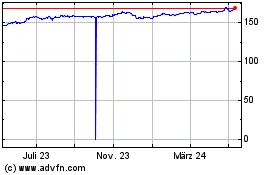Euro Climbs Amid Risk Appetite As Catalonia Worries Ease
03 Oktober 2017 - 9:14AM
RTTF2
The euro advanced against its key counterparts in European deals
on Tuesday amid risk appetite, as a sell-off in Spanish markets
eased after Spanish Prime Minister Mariano Rajoy attempted to
resolve the issue of Catalan independence.
Rajoy on Monday said the government will seek a joint response
with other political parties to the "pro-independence challenge" in
Catalonia.
The European Commision dismissed Catalonia's disputed
referendum, saying it as "not legal" under the Spanish Constitution
and urged dialogue between Barcelona and Madrid to solve the
crisis.
The European parliament will hold a special debate on Wednesday
on the issue.
Data from Eurostat showed that Eurozone producer prices grew the
most in three months in August.
Producer prices increased 2.5 percent year-on-year in August,
faster than the 2 percent rise seen in July. The annual rate
exceeded the expected 2.3 percent and was the fastest since June
2017.
Excluding energy, producer price inflation rose marginally to
2.2 percent from 2.1 percent a month ago.
The currency showed mixed trading in the Asian session. While it
rose against the yen and the franc, it held steady against the
pound. Against the greenback, it fell.
The euro climbed to 1.1751 against the greenback, from an early
1-1/2-month low of 1.1696.The euro is likely to find resistance
around the 1.19 region.
The euro advanced to a 4-day high of 1.1464 against the franc,
off its early low of 1.1428. The next possible resistance for the
euro-franc pair is seen around the 1.19 area.
The single currency reversed from an early 6-day low of 132.17
against the Japanese yen, bouncing off to 132.86.The euro is seen
finding resistance around the 135.00 level.
Survey data from the Cabinet Office showed that Japan's consumer
confidence improved more-than-expected in September.
The consumer sentiment index rose to 43.9 from 43.3 in August.
The expected reading was 43.5. A similar high score was last seen
in March.
The euro edged up to 0.8867 against the pound, after having
fallen to 0.8822 at 3:00 am ET. If the euro-pound pair extends
rise, 0.90 is possibly seen as its next resistance level.
Data from IHS Markit showed that the UK construction sector
contracted in September on weak new work.
The IHS Markit/Chartered Institute of Procurement & Supply
construction Purchasing Managers' Index fell to 48.1 in September
from 51.1 in August. The reading was expected to remain unchanged
at 51.1.
The euro rose to 1.5047 against the aussie and 1.4716 against
the loonie, from its early 5-day low of 1.4971 and a 4-day low of
1.4661, respectively. On the upside, 1.53 and 1.48 are likely seen
as the next resistance levels for the euro against the aussie and
the loonie, respectively.
The single currency spiked up to a weekly high of 1.6398 against
the kiwi, from a low of 1.6292 hit at 10:15 pm ET. The euro is
poised to challenge resistance around the 1.65 mark.
Looking ahead, at 8:30 am ET, Federal Reserve Governor Jerome
Powell speaks about regulatory reform at a financial regulation
event jointly hosted by Reuters and George Washington University in
Washington DC.
At 12:30 pm ET, the Bank of Canada Deputy Governor Sylvain Leduc
speaks about Canadian business creation and productivity at the
Sherbrooke Chamber of Commerce, in Quebec.
Euro vs Yen (FX:EURJPY)
Forex Chart
Von Mär 2024 bis Apr 2024

Euro vs Yen (FX:EURJPY)
Forex Chart
Von Apr 2023 bis Apr 2024
